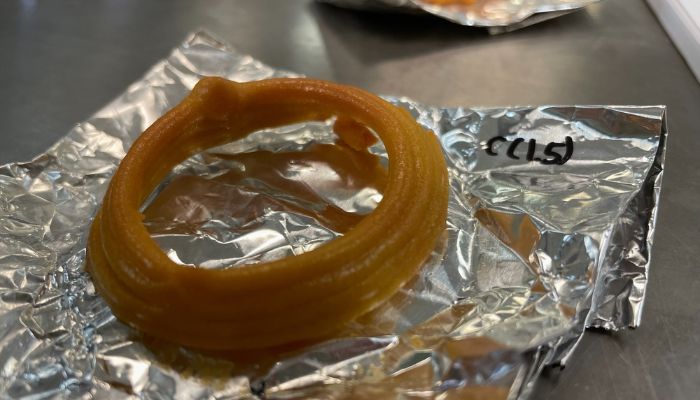
Humanity’s urge for food for seafood is huge and worldwide. A median individual eats over 45 kilos of fish per 12 months, however overfishing, accessibility, affordability, and growing ocean contamination with harmful supplies resembling microplastics and heavy metals have pushed pioneers to hunt out acquainted flavors in new locations. Demand for extra plant-based seafood options has steadily risen over the previous few years, seeing the introduction of 3D printed, plant-based fish substitutes resembling salmon, tuna, and even eel. In most up-to-date information, researchers on the College of Singapore have been working so as to add calamari rings to the menu subsequent with the assistance of food-grade 3D printing utilizing edible bioink.
Dr. Dejian Huang heads the group on the College of Singapore that’s behind the analysis and creation of latest 3D printed plant-based substitutes. The group has beforehand labored on salmon and shrimp options and has now set its sights on the viability of plant-based calamari. Dr. Huang explains, “Plant-based seafood mimics are on the market, however the substances don’t often embody protein. We needed to make protein-based merchandise which can be nutritionally equal to or higher than actual seafood and deal with meals sustainability”. As an early convert to plant-based meat substitutes may inform you, it may be troublesome to nail the correct steadiness of taste and texture to carefully resemble the properties of meat. The analysis group is due to this fact paying shut consideration to each on this vegan calamari by utilizing a protein-based bioink manufactured from microalgae and mung beans, combined with omega-3 fatty acids. The bioink is then became a paste after which extruded by a food-grade 3D printer.

The primary of the 3D printed calamari rings after being air fried (Picture Credit: Poornima Vijayan)
Algae has already confirmed to be a game-changing part in a number of fields, with promising traits for CO2 discount and medical advances. Furthermore, as a meals supply it requires far fewer sources than conventional agriculture. The College of Singapore group particularly selected microalgae for its protein density, environmental sustainability and slight fishy taste which provides to the general character of the fake calamari. Mung beans, the second protein, are additionally plentiful and available. An extra profit? The surplus materials notably from the manufacture of mung bean vermicelli or glass noodles can be utilized in bioink for 3D printed meals as a substitute of changing into waste.
Using algae based mostly bioink supplies producers with a less expensive, renewable, and environmentally pleasant different to meat proteins and within the case of seafood, can present shoppers with fish or shellfish allergy symptoms the chance to get pleasure from it as nicely. Creating extra versatile meals selections like calamari additionally offers shoppers the liberty to organize it nonetheless they like, be it within the pan, oven, or fryer. Their end-goal consists of making a product that’s able to large-scale manufacturing, ultimately reaching restaurant kitchens and grocery store cabinets. After making an attempt their first take a look at pattern cooked in an air fryer, the group is hopeful that extra 3D printed options to seafood resembling calamari could start industrial manufacturing within the subsequent few years. For extra data, you’ll be able to learn the total story HERE.
How would you serve up a plate of 3D printed calamari? Tell us in a remark beneath or on our LinkedIn, Fb, and Twitter pages! Don’t overlook to enroll in our free weekly Publication right here, the most recent 3D printing information straight to your inbox! You may also discover all our movies on our YouTube channel.
*Cowl Picture Credit: Nhobgood Nick Hobgood, Personal work, CC BY-SA 3.0